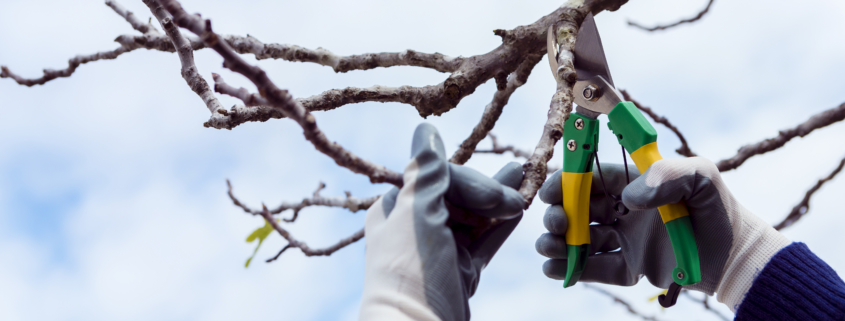Winter Pruning: Is Now the Time?
From mid-summer blooms and fall’s abundant yield of beans, greens, squash and SO much zucchini, your garden and landscape offers the color – and flavors! – you need to weather the long winter. Its beauty and harvest help keep you physically and mentally healthy during the dark days of a new year. What can you do to repay and recharge your land while it “sleeps” away the cold months?
What You Need to Know About Winter Pruning
Typically, pruning is done in June/July and September/October, if the weather cooperates. For example, these are great times to take care of ground cover, hedges, shrubs, small ornamental trees, and trees less than 15 feet in height. Our team uses selective hand pruning and shearing methods to ensure optimal results.
That said, there are some plants and shrubs that can benefit from winter pruning. During the winter, most plant species go into a dormant state. Think of it like hunkering down under a blanket and waiting for the warmth to return. In this state, they stop actively growing. They’re not dead; just resting. Pruning at this point in the year allows the plant to recover fully before it flowers in the spring; the plant can then direct all of its energy to producing new, healthy growth.
The keyword is some plants. The following varieties can be safely and effectively pruned in winter:
- Flowering shrubs that bloom later in summer (prune late winter/early spring)
- Deciduous shrubs that do not flower such as barberry varieties (prune late winter/early spring)
- Evergreen shrubs like Yew and Juniper (prune late winter/early spring)
- Conifers like pine trees and Douglas fir (prune in winter)
- Oaks (prune in February to prevent damage from sap-eating beetles, which become active in March)
While we’re on the subject, here’s what you should not prune in winter:
- Shrubs that flower in the spring and early summer like lilacs, jasmine, and rhododendron (prune immediately after blooms fade)
- Trees that flower in early in spring such as dogwood, apple, and cherry (prune in late fall)
If you take shears to them in the winter, they do not have enough recovery time to produce new growth. Let them rest and welcome in the spring when it’s time!
Rejuvenation Pruning
Most plants, shrubs, and trees require at least a bit of pruning (more or less, depending on the species). Think of it like a haircut for your greenery. You want healthy, strong, sustainable growth – not an out of control mess that’s taking over your yard. When you are dealing with thick, overgrown branches that do not produce leaves, blossoms, or fruit, you may have to take more drastic action.
Rejuvenation pruning involves the removal of old, overgrown limbs so that the plant can produce new, healthy ones. You can do this gradually or do a “hard prune,” which essentially takes the shrub down to a six to 12-inch stalk to encourage healthy growth. Not all plants will tolerate this – and you may not want an unsightly stick where your shrub, bush, or tree used to be. It’s best to get some professional guidance to determine the right course of action for your landscape and goals.
If you do have landscape features that need rejuvenation pruning, though, winter is a fine time to do it – even with spring-flowering shrubs. It will take a while for regrowth, but in the end, you’ll enjoy a much healthier plant.
Shear Perfection
Pruning can be intimidating, even for experienced gardeners and DIY lawn enthusiasts. In addition to when you cut, you need to think of how, how much, and in which locations. There is a strategy to ensuring the health and longevity of your trees, shrubs, and bushes. Get the help you need to maintain a beautiful landscape… and free up the time you need to enjoy it.
Contact GreenImage about our pruning services, so you and your plants can get a good rest this winter.



